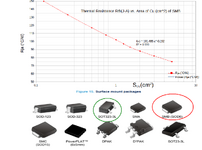cupoftea
Advanced Member level 6

Hi,
A customer has sent us a product PCB to modify....
We have eight linear regulators, using SOT223 BJTs (PBSS4540).
Vin=20V
Vout = 2V
Load is 64mA.
(There's a current clamp aswell, but no need to go into it)
So the SOT223 dissipates 1.1W.
Trouble is, there are eight of these linear regs, and the eight SOT223's are "shoulder to shoulder" on the PCB. (no other room).
PCB copper is 1oz. The area directly under each SOT223 has a copper pour, so the total copper pour area is 22mm^2.
Board is 4 layer but there is no room for a bottom copper pour, or any intermediary layer copper pour.
The eight SOT223's are gap-padded to the heatsink below.
The gap pad is just big enough to cover the eight SOT223's
The gap pad is filling the 3.2mm gap between the plastic top of the SOT223's and the heatsink.
In a thermal test, with all eight regulators fully loaded (1.1W dissipation in each SOT223), i measured with thermocouple, 75degC at the case of each SOT223.
This was in 20degC ambient. (Kit must operate to 40degC ambient.)
The thing is, the TLV1117 datasheet from ti.com, on page 4, states that SOT223 has 54 degC/Watt for Rth(J-case top).
So that means, our SOT223 junctions will be 126 degC when ambient is 20degC....but will be 146degC when ambient is 40degC.
This is obviously too hot.
Woudl you agree, it is not acceptable to operate any SOT223 above 110degC junction? (150degC is abs max, but we all know that any operation
above 110degC means premature failures
through expansion/contraction problems in the SOT223 package.
And do you agree with the 54 degC/Watt Rth(j-case Top) for SOT223?
TLV1117 page 4 gives Rth(j-case top) for SOT223 (DCY package)
A customer has sent us a product PCB to modify....
We have eight linear regulators, using SOT223 BJTs (PBSS4540).
Vin=20V
Vout = 2V
Load is 64mA.
(There's a current clamp aswell, but no need to go into it)
So the SOT223 dissipates 1.1W.
Trouble is, there are eight of these linear regs, and the eight SOT223's are "shoulder to shoulder" on the PCB. (no other room).
PCB copper is 1oz. The area directly under each SOT223 has a copper pour, so the total copper pour area is 22mm^2.
Board is 4 layer but there is no room for a bottom copper pour, or any intermediary layer copper pour.
The eight SOT223's are gap-padded to the heatsink below.
The gap pad is just big enough to cover the eight SOT223's
The gap pad is filling the 3.2mm gap between the plastic top of the SOT223's and the heatsink.
In a thermal test, with all eight regulators fully loaded (1.1W dissipation in each SOT223), i measured with thermocouple, 75degC at the case of each SOT223.
This was in 20degC ambient. (Kit must operate to 40degC ambient.)
The thing is, the TLV1117 datasheet from ti.com, on page 4, states that SOT223 has 54 degC/Watt for Rth(J-case top).
So that means, our SOT223 junctions will be 126 degC when ambient is 20degC....but will be 146degC when ambient is 40degC.
This is obviously too hot.
Woudl you agree, it is not acceptable to operate any SOT223 above 110degC junction? (150degC is abs max, but we all know that any operation
above 110degC means premature failures
through expansion/contraction problems in the SOT223 package.
And do you agree with the 54 degC/Watt Rth(j-case Top) for SOT223?
TLV1117 page 4 gives Rth(j-case top) for SOT223 (DCY package)


